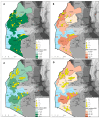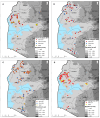Occurrence and Distribution of Major Cassava Pests and Diseases in Cultivated Cassava Varieties in Western Kenya
- PMID: 39339946
- PMCID: PMC11437512
- DOI: 10.3390/v16091469
Occurrence and Distribution of Major Cassava Pests and Diseases in Cultivated Cassava Varieties in Western Kenya
Abstract
Cassava is an important food crop in western Kenya, yet its production is challenged by pests and diseases that require routine monitoring to guide development and deployment of control strategies. Field surveys were conducted in 2022 and 2023 to determine the prevalence, incidence and severity of cassava mosaic disease (CMD) and cassava brown streak disease (CBSD), whitefly numbers and incidence of cassava green mite (CGM) in six counties of western Kenya. Details of the encountered cassava varieties were carefully recorded to determine the adoption of improved varieties. A total of 29 varieties were recorded, out of which 13 were improved, although the improved varieties were predominant in 60% of fields and the most widely grown variety was MM96/4271. The CMD incidence was higher in 2022 (26.4%) compared to 2023 (10.1%), although the proportion of CMD attributable to whitefly infection was greater (50.6%) in 2023 than in 2022 (18.0%). The CBSD incidence in 2022 was 6.4%, while in 2023 it was 4.1%. The CMD incidence was significantly lower (5.9%) for the improved varieties than it was for the local varieties (35.9%), although the CBSD incidence did not differ significantly between the improved (2.3%) and local varieties (9.7%). Cassava brown streak virus (CBSV) and Ugandan cassava brown streak virus (UCBSV) were both detected. Most infections were single CBSV infections (82.9%), followed by single UCBSV (34.3%) and coinfection with both viruses (16.7%). Whiteflies were more abundant in 2023, in which 28% of the fields had super-abundant populations of >100/plant, compared to 5% in 2022. KASP SNP genotyping designated 92.8% of the specimens as SSA-ECA for 2022, while it was 94.4% for 2023. The cassava green mite incidence was 65.4% in 2022 compared to 79.9% in 2023. This study demonstrates that cassava viruses, whiteflies and cassava green mites continue to be important constraints to cassava production in western Kenya, although the widespread cultivation of improved varieties is reducing the impact of cassava viruses. The more widespread application of high-quality seed delivery mechanisms could further enhance the management of these pests/diseases, coupled with wider application of IPM measures for whiteflies and mites.
Keywords: Bemisia tabaci; cassava brown streak disease; cassava green mite; cassava mosaic disease; whitefly.
Conflict of interest statement
The authors declare no conflicts of interest.
Figures




References
-
- The Food and Agriculture Organization Statistics, FAOSTAT. 2022. [(accessed on 20 June 2024)]. Available online: https://www.fao.org/faostat/en/#data/QCL.
-
- Mwango’mbe A.W., Mbugua S.K., Olubayo F.O., Ngugi E.K., Mwinga R., Munga T., Muiru W.M. Challenges and opportunities in cassava production among the rural households in Kilifi County in the Coastal region of Kenya. J. Biol. Agric. Healthc. 2013;10:2224–3208.
-
- Were M.N., Mukoye B., Osogo A.K., Mangeni B.C., Nyamwamu P.A.A., Ogemah V.K., Muoma J.V., Winter S., Were H.K. Occurrence and distribution of begomoviruses infecting cassava in Western Kenya. Plant. 2016;4:108–113. doi: 10.11648/j.plant.20160406.18. - DOI
-
- Munguti F.M., Nyaboga E.N., Kilalo D.C., Yegon H.K., Macharia I., Mwango’mbe A.W. Survey of cassava brown streak disease and association of factors influencing its epidemics in smallholder cassava cropping systems of coastal Kenya. Front. Sustain. Food Syst. 2023;6:1015315. doi: 10.3389/fsufs.2022.1015315. - DOI
Publication types
MeSH terms
Grants and funding
LinkOut - more resources
Full Text Sources
Research Materials

